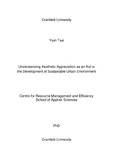JavaScript is disabled for your browser. Some features of this site may not work without it.
| dc.contributor.advisor | Batty, W. J. | |
| dc.contributor.author | Tsai, Yiyin | |
| dc.date.accessioned | 2012-12-17T14:19:11Z | |
| dc.date.available | 2012-12-17T14:19:11Z | |
| dc.date.issued | 2009-08 | |
| dc.identifier.uri | http://dspace.lib.cranfield.ac.uk/handle/1826/7709 | |
| dc.description.abstract | Sustainable management of the existing built environment is becoming increasingly important in the construction industry. Consequently, more emphasis has emerged to consider issues of refurbishment and renovation. The aesthetic values of buildings are recognised as critical guiding attributes both in terms of the potential long-term aspects of sustainability and as basic reasoning for the continued maintenance and management of existing buildings. A process is required that will allow different aspects of a potential refurbishment project to be assessed objectively and weighted equally when deciding whether an existing building should be preserved, adapted or demolished. The thesis attempts to provide a useful understanding in terms of the aesthetic appreciation when considering future sustainable management of the existing built environment. Two parallel research activities were initiated to examine important aspects of human aesthetic perception regarding buildings in the built environment. The first addressed the potentially universal and culturally derived aspects of human responses in perceiving the aesthetic qualities of houses from 3 counties through the agency of colour photographs. A three language semantic differential scale was developed to be linguistically equivalent so that an inter-cultural research tool could be derived to ascertain an understanding of people’s aesthetic appreciation through the use of descriptive adjectives. The second activity was initiated to develop and test the concept of building endurance regarding the general public’s aesthetic appreciation of existing buildings. A methodological framework was developed to facilitate investigation of changes of human aesthetic response related to changes in the built environment. Cross-cultural variables and respondent’s age parameter were found to be influential in conditioning people’s aesthetic responses to photographs of houses and urban streetscapes. Few differences were observed between male and female aesthetic responses both in their descriptions of visual quality and their ideal house profile. A cross-cultural, universal profile of ideal house qualities was obtained by utilizing responses from the cross-language semantic differential scale. However differences in people’s aesthetic preference selections were observed. Additionally, respondents’ preference rankings demonstrated that the general public supports the desire of preserving the existing urban condition. Appropriate refurbishment strategies were suggested to guide decision making when assessing changes to be made to an existing building and its surrounding environment while at the same time maintaining people’s aesthetic appreciation. The research activities presented in this thesis provide a contribution to current knowledge of the general public’s aesthetic appreciation of the existing buildings and built environments which may be used to aid future sustainable development of the built environment. | en_UK |
| dc.language.iso | en | en_UK |
| dc.publisher | Cranfield University | en_UK |
| dc.rights | © Cranfield University 2009. All right reserved. No part of this publication may be reproduced without written permission of the copyright owner. | en_UK |
| dc.title | Understanding aesthetic appreciation as an aid to the development of sustainable urban environment | en_UK |
| dc.type | Thesis or dissertation | en_UK |
| dc.type.qualificationlevel | Doctoral | en_UK |
| dc.type.qualificationname | PhD | en_UK |

